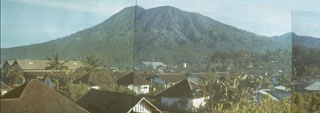Report on Tangkoko-Duasudara (Indonesia) — 21 April-27 April 2010
Smithsonian Institution / US Geological Survey
Weekly Volcanic Activity Report, 21 April-27 April 2010
Managing Editor: Sally Sennert.
Please cite this report as:
Global Volcanism Program, 2010. Report on Tangkoko-Duasudara (Indonesia) (Sennert, S, ed.). Weekly Volcanic Activity Report, 21 April-27 April 2010. Smithsonian Institution and US Geological Survey.
Tangkoko-Duasudara
Indonesia
1.518°N, 125.185°E; summit elev. 1334 m
All times are local (unless otherwise noted)
Based on analyses of satellite imagery, the Darwin VAAC reported that on 23 April a possible ash plume from Tongkoko rose to an altitude of 10.7 km (35,000 ft) a.s.l. [Note: The Darwin VAAC later stated that, according to CVGHM, the plume was caused by a fire and not an eruption.]
Geological Summary. The eastern peninsula at the far NE end of Sulawesi near the city of Bitung is occupied by a volcanic complex consisting of two major edifices within a nature reserve. To the north is Tangkoko (also known as Tongkoko), with a large caldera (~3 x 1.5 km) elongated towards the SE from the highest rim point; the rim at the opposite end is more than 400 m lower. Eruptions occurred from the summit crater in the 17th century and in 1801, when the caldera also reportedly contained a cone surrounded by a lake. About 1.5 km down the outer E flank is the Batuangus (or Batu Angus) lava dome, formed in 1801, along with an adjacent vent (Baru Batuangus) that has been the source of all subsequent eruptions. The higher twin-peaked Duasudara (also Dua Suadara) stratovolcano is about 4.5 km SW of the Tangkoko summit. A NE-facing open crater appears to have a hummocky debris flow that reaches the base of the Tangkoko edifice.

